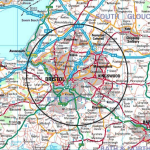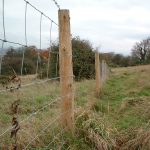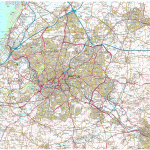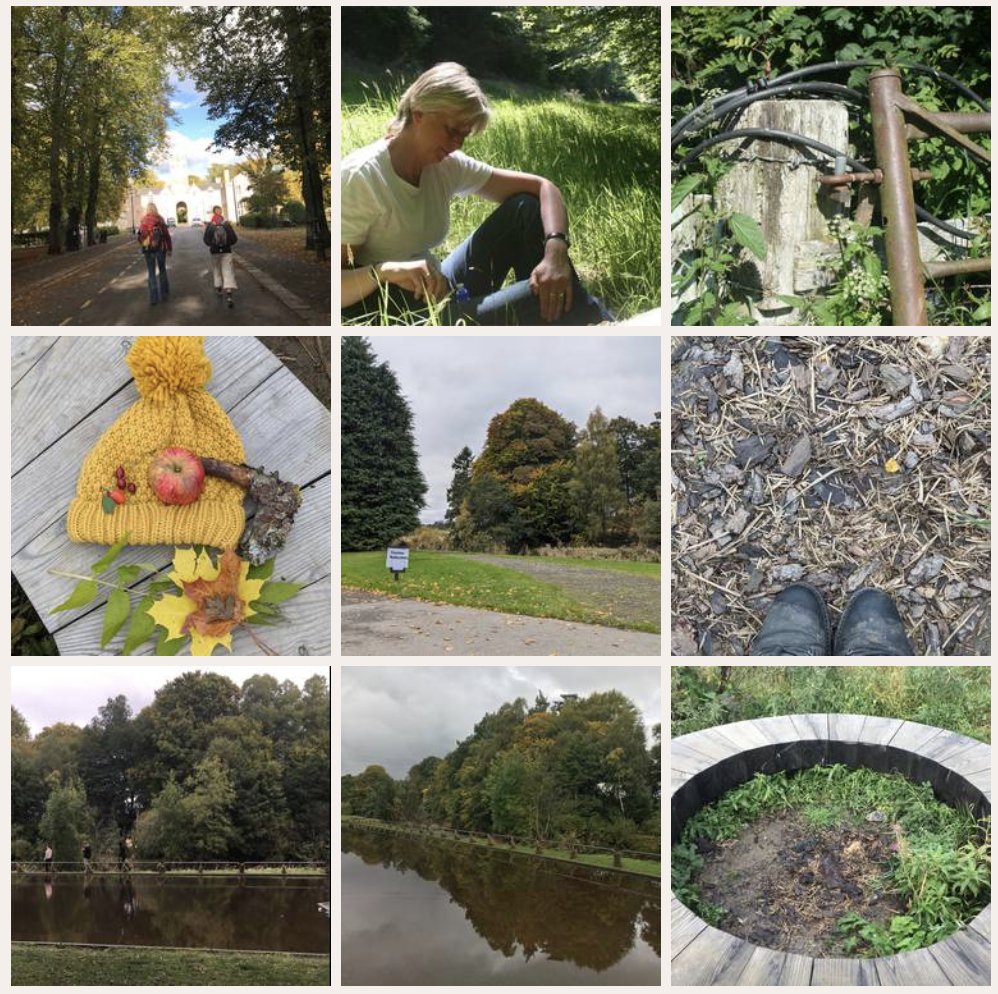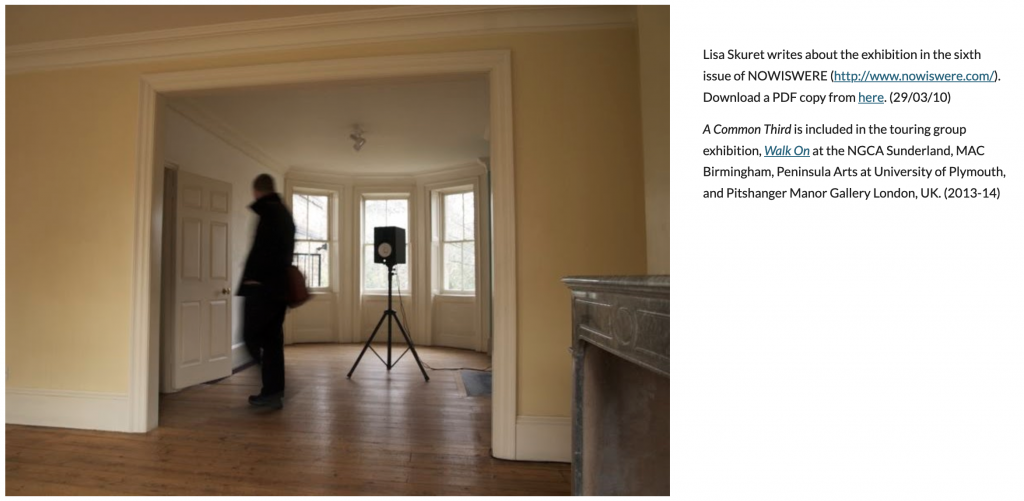A collection of soundwalks made with Filipina domestic and care workers employed “behind closed doors” in the Lebanon and the UK. Check out the soundwalks.
Category Archives: Pair Walks
Heath Bunting and Kayle Brandon, D’Fence Cuts (2001)
“Heath Bunting emerged from the 1980s art scene committed to building open, democratic communications systems and social contexts. Throughout his career, he has explored multiple media including graffiti and performance art and has staged numerous interventionist projects, as well as being a pioneer in the field of Internet Art. Bunting began collaborating with artist Kyle Brandon in 2001.” [credit]
These artists devised a circular tour (see map), and by night stealthily cut some fences as part of their Borderxing project. BorderXing serves as a pratical guide to crossing major international borders, legally or illegally. It was a type of physical hacking of space, cutting anything that impeded their walk – D’Fence Cuts. Below is an excerpt from their tour de fence catalog:
“tour de fence is the answer to your real needs. while the internet promised to level out all barriers, tour de fence enables you to surmount the fences out there that people erect to obstruct your way every day. from wire netting to ru stic fence, from steel door to close security system, tour de fence offers you the necessary know-how for unhampered movement. tour de fence is the direct way.
learn offroad mobility within high security architecture. cross over stretches of land in the right direction. penetrate the underground area of your city. tour de fence puts an end to the relocation of your movements into virtual space. use the tour de fence! become a tour de fence amateur team. pass this handbook on to others. propagate tour de fence.
by doing so you will become part of the international tour de fence community. as a reader, a free-climber or by sending one of the 24 tour de fence postcard in this book.
participate now! tour de fence’s vision is to do what we want.
…
tour de fence acknowledges fence as metaphor for private property. fence as a supposedly temporary, often mobile barrier performing functions of inclusion and exclusion, entrapment and guided freedom, decoration, safety, user boun dary, protection from hazard, flow control, visual screening and user separation.
fence is a permeable filter system defining permitted use and users. light, wind, insects, water, plants and sound pass unhindered while high order life forms such as·humans, fish, cattle and cars are engaged:
development of fence.
up to now the vertical has generally been private while the horizontal public. increasingly, vertical fences are being rotated to the horizontal and enlarged over large areas of land, as all use and users are embraced in total control.
tour de fence recognises the transformation of framed freedom into restricted open-range roaming; the re-alignment of unknown possibilities into known re peatables. users are permitted to skate across flattened surface of fence, but not to pass through – the fence is everywhere.” (credit)
The Walking Reading Group (2013)
Walking Reading Group Trailer from SPACE on Vimeo.
“The Walking Reading Group, running since 2013, is a project that facilitates knowledge exchange in an intimate and dynamic way through discussing texts whilst walking together. In this reading group the table is broken up by the street and the dominant voice is replaced with the sound of conversation partners talking simultaneously. Anyone can participate and the walks are free to attend. TWRG was founded by Ania Bas and Simone Mair and is run by Lydia Ashman and Ania Bas.
As a result of our residency at Art House, Jersey in 2017, we initiated an edition on Care, our ongoing long term focus, in which we are working with partners across sectors – including the arts, health, science – to explore and reveal practices of care. So far in this edition, we have collaborated with Ash Project, Whitstable Biennale, The Photographers’ Gallery, [SPACE], St Joseph’s Hospice, The Nine Elms Vauxhall Partnership, Arts Territory and Od Arts Festival.” [credit]
“Texts are provided in advance and walks begin at ___ where participants can also pick up a copy of the specially commissioned publication.
The resulting experience of walking for up to two hours, swapping conversation partners and perspectives several times, is one of intimacy created through sharing and listening, the respect for ideas and difference. Thoughts are processed quickly, the surrounding landscape becomes a blur, time is suspended and within this moment bonds between strangers are formed. …
Each walk is underpinned by a selection of texts that explore the theme of ____ from multiple points of views. All four walks start at ____ but each finishes in a different part of ____. Exact finish locations will be disclosed later.” [credit]
May Murad and Rachel Ashton, Walking Without Walls (2017-18)
“Digital Dialogue on Peace, Friendship and Boundaries
Painters May Murad (Gaza) and Rachel Ashton (Huntly) digitally collaborated throughout 2017 to plan two 2018 Slow Marathons in the places they come from.
2018 is the centenary year of the end of WW1. It is also the year when Britain occupied the Palestinian territory of Gaza, – its turbulent history has since been shaped by this event. The Gaza strip is of exact marathon length (26 miles/42k) with walls at each end. We can not visit, and they can not come out. How can we extend and keep up friendships when we can never visit each other? Can socially engage if we never physically meet the other?
The digitally driven exchange project Walking without Walls partnership explored how we can collaborate artistically and socially despite restrictive political situations. The two artists shared through image and video, skype and whatsapp, sketches and text their respective landscapes in their very different geo-political settings. While Rachel negotiated her way with landowners and farmers, May dealt with the complexities of living in an occupied territory. Drawing on the plant journals of WW1 pacifist Rosa Luxemburg – created whilst imprisoned – the artists recorded and shared plants with curing powers in their different climates, while looking for new paths, friendship and ways of healing along the way.
Walking Without Walls formed two marathon length walks. One in Gaza and the other along the river Isla from Dufftown via Keith to Huntly. It featured exhibitions in both places, a catalogue of healing plants and a Pathmakers’ Gathering on political walking. See photos from the day here.
The artists’ path-making explorations into their own land were accompanied by a year-long exchange through various digital applications. In a time of rising nationalism and restrictive legislations that hinder crossings of national borders, the two artists have been exploring opportunities and limits of new technologies in fostering transnational long-distance collaboration. Paintings, drawings and other documentation resulting from their visual exchange was displayed at Tate Exchange on 25th May. ” [credit]
Claudia Zeiske, Walking Lunches (2010-2020)
Walking Lunches are a series of moving meetings between Claudia Zeiske and artists, arts professionals and other participants.
Claudia provides a written agenda prior to the walking lunch, as well as sandwiches and tea during the walk. The lunch partner brings a camera and takes three pictures (portrait, landscape, still-life) on the walk. Afterwards Claudia writes minutes and archives them, along with the images taken by the partner.
Interested in a walking lunch? Contact Claudia
Recommended: good shoes, waterproofs, hat and gloves
Walking Lunches are an adaptation of ‘working lunches’, combining the purpose of a business meeting with fitness and environment appreciation. The idea is that instead of lunch-time meetings people are encouraged to undertake movable get-togethers, where they walk for the duration of a normal meeting (i.e. between 1-2 hours). Targeted for busy people who want to keep fit but can’t ‘afford’ the time.
‘The intention is to set up a network of walking lunchers which has a snowball effect over a 6 month period. These moving meetings will be orchestrated by myself; each week I will encourage at least one other person to walk. The walking partner in turn will commit to undertake at least 2 further walking lunches. If successful this project should create an exponential rise in the number of people walking over the 6 months of the project. If everybody I walk with (minimum 26 people), walks with at least two other people, this will already be 26+2×26 = 78 people. One can imagine how much this number will go up if every one of those walkers encourages 2 more walkers, and they in turn do the same…..’ Claudia Zeiske”
Clare Qualmann, Perambulator (2012-)
Via Qualmann: Perambulator is an ongoing artwork that explores the experience of walking with a pram (or pushchair, stroller or buggy). Working from an auto-ethnographic standpoint the project explores gendered spaces, maternal narratives and shifting identities, inequality and mobilities. Elements of the work have been produced for Lewisham Arthouse, London, Deveron Projects, Huntley, and Flux Factory, New York.
Please visit the perambulator website for more information: https://huntlyperambulator.wordpress.com/
Simon Pope “A Common Third (With Hayden Lorimer) 2010

[credit]
Simon Pope (1966-)
“Simon Pope’s work has been central to the way in which walking as a method of art production has been rethought in recent years. Pope has remarked that “My recent work has focused on walking as a model for processes of dialogue and negotiation”. He views walking as analogous to the processes of what might be called ‘togetherness’, and describes his work as fundamentally “dialogic”.
To create ‘A Common Third’, Pope undertook walks with invited guests to places that neither he nor his collaborator knew beforehand. Accordingly, both were required to take decisions spontaneously and to negotiate what route and course of action to take.
Pope’s work presents audio recordings made later by the participants about the process – about the mental pathways taken as much as the literal ones. The romantic tradition of walking often refers to solitariness and less often to walking as a form of sociability. Pope examines how relationships, including power relationships, determine or structure our experience and expectations of landscape. His works are experiments in discovering how we approach walking, and what we expect from it. In ‘A Common Third’, he draws our attention to the ways in which law, cultural practice and tradition impact on us – challenging the ahistorical, asocial idea of walking offering a realm of infinite liberty that supposedly sits in contrasts to urban experience.”
Carrie Schneider, “Hear Our Houston” (2012-2015)
“Hear Our Houston is a hub of public generated audio walking tours around our city.
All sorts of folks from all around town take a walk, record their thoughts, observations, stories, memories, and knowledge along the way. They then upload the tour to HearOurHouston.com where anyone can download it for free and retrace the tour maker’s steps, layering meaning into geography, and trying on another person’s perspective.
Some tours rely on an expert eye view. Other tours share intimate glimpse of the neighborhoods they call home. Some tours are an unexpected pairing of a fresh pair of eyes on a well trodden path. Some tours are really about getting to walk a mile in someone else’s shoes, paths that we may be curious about but don’t always have the chance to understand.
All of these tours give us a window into another part of our world.
All of these tours celebrate the journey.
They are not a list of easily consumable hotspots. From point a to point b, you walk, you discover meaning in details you never noticed, in in-between spaces you wouldn’t have sought to arrive at, and see even the familiar in a new light.
Houston is a city of great but hidden richness only truly discovered by experience and word of mouth. In a place where walking is a radical act, Hear Our Houston is preserving our hidden gems, voicing meaning within geography, and celebrating our common sense of space.” (credit)
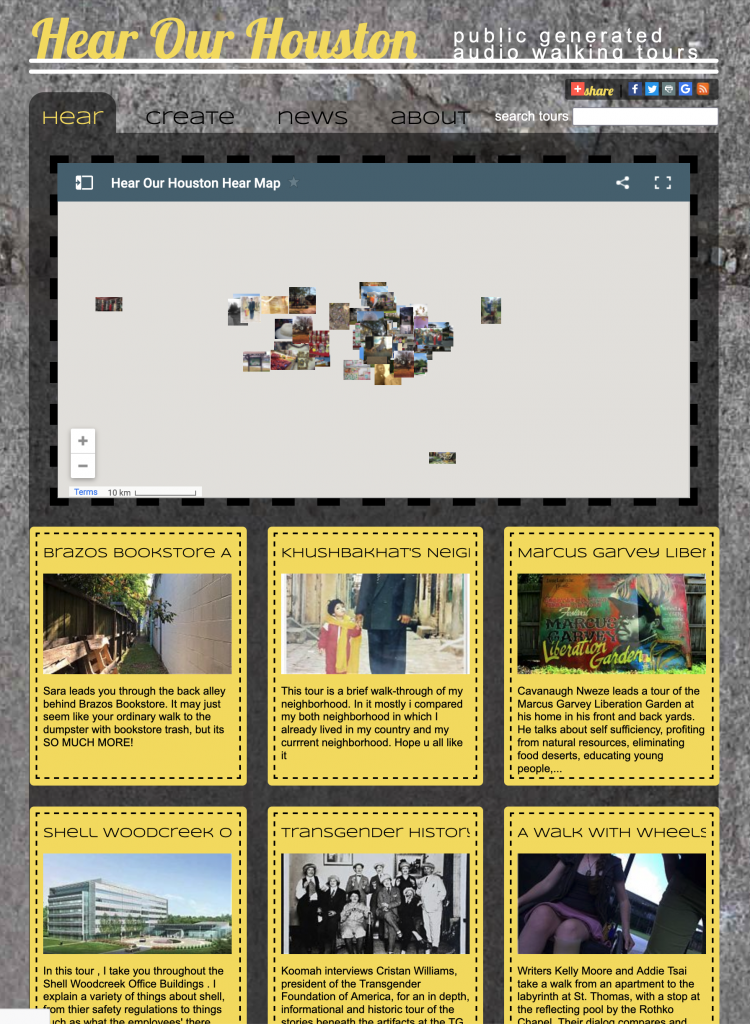
Screen Shot of Hear our Houston website
Sophie Calle, Suite Vénitienne (1980)
“At the end of January 1980, on the streets of Paris, I followed a man whom I lost sight of a few minutes later in the crowd. That very evening, quite by chance, he was introduced to me at an opening. During the course of our conversation, he told me he was planning an imminent trip to Venice. I decided to follow him.” – Sophie Calle

“Sophie Calle’s urban expeditions might be thought to recall Vito Acconci’s seminal performance work ‘Following’, made a decade earlier in which he tailed strangers chosen at random without their knowledge, up until they left public space for their homes or offices. In Calle’s work however, the relationship between the artist and their public is different. This is not merely because the expected gender roles, where men act as predators and women are vulnerable, are inverted. The artist’s motivations are unknowable, her ultimate goals opaque, and her behavior seemingly contradictory.
If we might imagine Acconci’s role implies that he is dangerous – is a stalker or assailant – Calle’s activities imply she is a kind of private detective or spy in pursuit of knowing more about a person than they do themselves. The presentation of her works as a kind of diary is intentionally alarming. We are meant to feel both a distance from her or repugnance at her behavior and, despite this, a simultaneous sympathy for or intimacy with her. Unlike a normal detective story, Calle’s work leaves us with both ‘who’ and ‘why’ left unresolved.” [credit]

“She met a man, Henri B., at a party. He said he was moving to Venice, so she moved to Venice and there, she began to follow him. Suite Vénitienne was the resulting book, first published in 1979 …Calle documents her attempts to follow her subject. She phoned hundreds of hotels, even visited the police station, to find out where he was staying, and persuaded a woman who lived opposite to let her photograph him from her window. Her photographs show the back of a raincoated man as he travels through the winding Venetian streets, a surreal and striking backdrop to her internalised mission. The very beauty of her surroundings has a filmic quality, intensifying the thriller-esque narrative of her project. Sometimes her means of following Henri B. are methodical – enlisting Venetian friends to make a phone call on her behalf – and sometimes arbitrary – following a delivery boy to see if he will lead her to him.” [credit]

Credit: //www.mersytzimopoulou.com/blog/2018/11/28/sophie-calle-suite-vnitienne-1979
Rut Blees Luxemburg, “Chance Encounters” (1995)
In the series, Blees Luxemburg photographed herself and another woman as they approached strangers in London’s Square Mile. The photos could be said to create a pattern of behaviors of people who inhabit in this urban landscape.
Her “Chance Encounters” are by no means actual chance encounters. Luxemburg spends a long time with the landscape itself before she snapped every photo. She is patient with her production, resulting in merely more than 20 photos per year[2]. She put a lot of conscious thought into every single shot because she wants her photos to tell stories and generate possibilities of profound thoughts. She wants her audience to think about what may have happened behind the subjects of these photos. In a way, we can say that they tell stories of the habitat without involving the inhabitants.
Another theme of her photography is the beauty of the unexpected. She loves to visit marginalized spaces in the city where we don’t usually consider appealing. She described herself as a Flaneuse while working on Chance Encounters. She wandered in the city and observed for serendipity. These moments come from the ignored part of our life but it reflects so much of our life.
